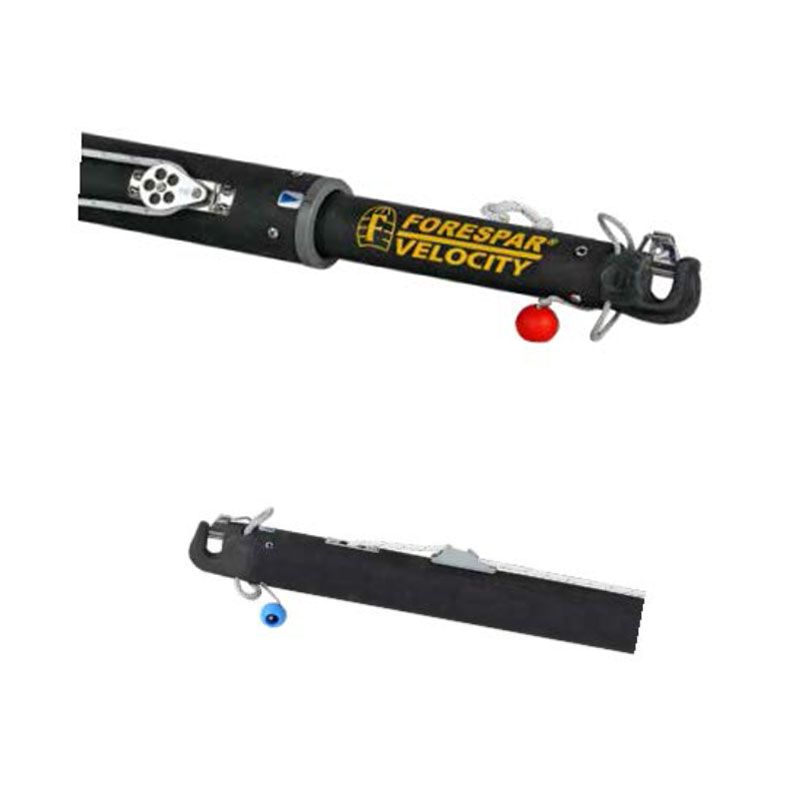 Whisker poles are used for non-spinnaker class racing and short-handed cruising, or whenever downwind performance is desired without the use of conventional spinnakers.
Whisker poles are used for non-spinnaker class racing and short-handed cruising, or whenever downwind performance is desired without the use of conventional spinnakers.
A properly sized and deployed whisker pole will allow the headsail to add considerable power and speed to downwind sailing. Telescoping whisker poles allow one pole to be used with furling headsails or multiple sized jibs and genoas on a given boat.
By projecting the headsail out to weather and out of the mainsail’s “wind shadow”, the headsail can fill and stabilize. Without a whisker pole, the headsail will flop from side to side, limp and useless. The use of a whisker pole will allow “wing on wing” sailing dead downwind with surprising performance. In recent years, asymmetrical spinnakers have become “all the rage” in off-the-wind sailing. These sails are subject to the same dynamics as jibs or genoas as you turn closer to dead down wind or try to sail “deep”. The use of a whisker pole to hold out the clew of the asymmetrical sail will stabilize the sail in the same way as it does a Genoa and allow better performance and an increased “sailing angle” with these sails.

Note that the telescoping whisker poles cannot support the tack loads of an asymmetrical, as these loads are far greater than the clew loads when the tack is set on the bow. In essence, trying to set the tack of an asymmetrical sail on a whisker pole is the same as trying to fly a spinnaker. Telescoping whisker poles cannot take these increased loads. A fixed-length pole of greater diameter is needed for this purpose, usually made of carbon fiber. Forespar® makes carbon fiber “Bow Poles” for this purpose. These are custom-built to the specific needs of the boat and require a bit more engineering and special mounting to function properly.
 Sizing
Sizing
Whisker poles should be 100% of the foot of whichever headsail is being flown. Measure from the tack to the clew and the whisker pole should be this length. You need to have some overlap in the pole. Poles telescoped to their maximum length are at their weakest, strength-wise. Diameter is a major function of strength. A 2-1/2” diameter tube is as much as 70% stronger than a 2” diameter tube. Size does matter!
The Forespar® catalog and Whisker Pole brochure have a sizing chart based on 36 years of empirical data. Labels on the whisker poles themselves also note the maximum size boat for each pole. This is what we strongly suggest you use in selecting the proper sized pole for your boat. Forespar® cannot offer any warranty on poles that are too small for the boat, based on this chart. Contact Forespar® customer service if you have any questions on proper sizing for your boat.
The smaller, twist-lock style poles (ADJ 4-8 & ADJ 6-12) come with a mast pad eye properly sized for these poles. This eye only should be used with these poles. The larger twist-lock style poles (HD 6-12 DL & ADJ 7-15 DL) should be used with the Forespar® PE-3-SF (#400001) or PE-3-SC (#400002) stainless steel mast pad eyes sold separately. Any fixed mast pad eye should be mounted on the forward centerline of the mast. This is so you can fly the pole from the single mount on both port and starboard sets. The height of the eye on the mast is determined by the height of the clew when the headsail is set. You want to fly the pole level, so if you have more than one headsail and they have different clew heights, you may want to mount two mast pad eyes, one high and one low.



































































































































































































